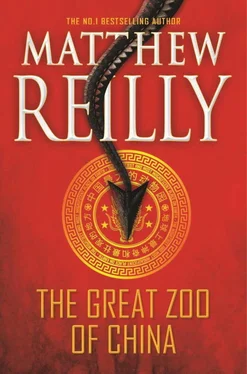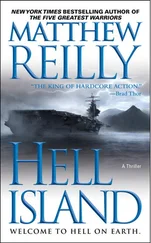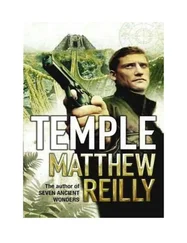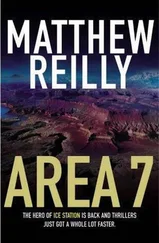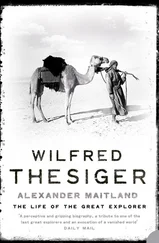The cable car pushed on.
Rising up directly in front of it, dominating the valley, was the central mountain. A silver disc-shaped structure sat atop its summit.
‘What do you think that is?’ CJ asked Hamish. ‘A revolving restaurant?’
Hamish shrugged. ‘Or a captured flying saucer.’
Hu stepped forward, resuming his presentation: ‘We think it was the thick layer of nickel in the earth here that saved these animals from the meteor strike that wiped out the dinosaurs 65 million years ago. Two kilometres of solid nickel insulated them from the impact and since the dragons were buried so deep and their hibernation skills so advanced, they were able to keep hibernating through the thousand-year winter that followed the meteor impact. Our zoo is built on top of the second-largest nickel deposit in these parts; the largest is over at Crater Lake about fifteen kilometres to the northwest.’
Wolfe said, ‘It’s a pity you couldn’t build your zoo around Crater Lake. Now that would have been a sight.’
‘Indeed,’ Hu said. ‘In any case, in November 1979, miners in a nickel mine near here broke through to a most unusual underground passageway. It was unusual because it was not natural; it had been dug out of the nickel—which is no mean feat given how hard nickel is—and then refilled with soil that had settled into it over the centuries. We dug out that soil to discover that the tunnel led to a cavern two kilometres underground, a cavern that was filled with eggs, eighty-eight of them to be precise, large leathery eggs that were bigger than any egg ever seen on this planet.
‘Now, for over two thousand years, this area has fostered dragon myths and legends, usually involving a lone dragon tormenting the locals for a short period. We believe those legends related to this nest: that every now and then, a lone juvenile dragon would leave the nest to test the atmosphere and see if it was suitable for the rest of the clan to resurface.’
Wolfe said, ‘November 1979. That was when the Iranian hostage crisis was going on.’
‘Correct,’ Hu said. ‘While it was a most unpleasant event for America, it was quite fortuitous for us, for it occupied the world’s attention for well over the next year, allowing our experts to examine the cavern in absolute secrecy. Deputy Director Zhang can provide the technical history of what happened next.’
Hu stepped aside and Zhang took over smoothly: ‘We brought in reptile experts to examine the eggs. They determined that they were not fossils but rather living ova containing animals in deep hibernation. X-rays and ultrasound scans revealed that the eggs contained lizard-like foetuses curled into tight balls.
‘We closed the nickel mine and dispatched all the workers. We then lined the walls of the cavern with cameras and sensors of every kind—temperature, humidity, sound, ultrasound—so that we might learn all we could about this astonishing discovery.
‘But we did not seal the cavern. Instead we sealed the land above it. We built a massive steel dome—it still stands over the Nesting Centre to the west of this valley, the oldest structure here at the Great Zoo. And then we waited. Waited and waited.
‘And then in July 1981 one of the eggs hatched.
‘A dragon emerged, covered in birth matter. It was a baby prince, a red-bellied black, and the size of a dog. The whole event was filmed. It is amazing footage. The prince ate two of its brethren, consuming the albumen and vitellus of those eggs, giving it strength, and then it went to the tunnel leading to the surface. It emerged inside our steel dome, sniffed the air, tested the water… and then it went back down to its cavern and began awakening the other eggs.
‘When the other eggs began to hatch, we had already prepared our facility up on the surface. When they emerged, we caught them one by one.’
‘But you didn’t tell anyone?’ Wolfe said.
‘This was the greatest zoological discovery in history ,’ Zhang said. ‘We wanted to make sure of what we had. We wanted to make sure the dragons would survive. If we showed the world a single specimen and it died, we would become an international laughing stock.’
Hu stepped forward and interjected: ‘It was also felt by some senior Party officials that this discovery could be the making of modern China, so it was decided that it should be kept secret until we could show it off to the world. It was thus determined that a zoo would be built on top of our discovery. And so it was. This zoo has been a project nearly forty years in the making.’
Hamish gave a low whistle. ‘Now that’s what I call patience.’
‘In any event,’ Zhang went on, ‘as the world warmed, more dragons hatched and our Nesting Centre began to overflow, so we built a second “Birthing Centre” beside it. And we fashioned this valley to suit our needs—it required twenty thousand workers, working over twenty years, and through sheer force of Chinese resolve, we bent the landscape to our will.’
‘You bent the landscape to your will?’ Aaron Perry asked. ‘What do you mean by that? Are you saying this valley isn’t natural?’
Hu decided to answer that one. He gestured toward the towering mountain ahead of them. ‘Oh, no, this valley is not natural at all. Our glorious central peak—Dragon Mountain—is natural, as are a few sections of the wall encircling this valley. But otherwise, this land only became a valley when our army of workers connected some rocky mounts by building the wall out of introduced limestone and concrete, turning it into a crater.’
Hu saw his guests turn and reappraise the colossal wall of the valley, now aware that it was not a naturally occurring landform. ‘The wall containing our main entrance building, for instance, is entirely artificial. All the lakes, waterfalls and other waterways in this zoo are entirely our creation. The smaller peaks are artificial, as are most of the cliffs—they were designed from the outset to accommodate the dragons.’
Hamish whistled again. ‘You have got to be kidding me…’
Zhang said, ‘Throughout the whole time the crater was being constructed, not one of the ordinary workers saw a single dragon. They thought they were building the world’s greatest zoo, which in a sense they were. They just didn’t know what the animals would be.
‘And all the while, we studied these creatures, watched them grow, watched them feed, observed their habits, even trained some of them, as you have seen.’
The cable car continued its slow glide over the megavalley, moving toward the central mountain. Dragons soared around it.
Hu said, ‘Thank you, Deputy Director.’ He turned to the group of visitors. ‘Now. Do you have any questions?’
The questions came rushing at him:
‘How did you build this place for twenty years without anyone in the world finding out?’ Perry asked.
‘How many dragons do you have here?’ Seymour Wolfe asked.
Hamish asked, ‘What do they eat? How do they interact? Do they fight each other?’
Ambassador Syme asked, ‘Apart from salt water, do they fear anything else?’
Hu held up his hands, laughing. ‘Okay! Okay! These are all very good questions and I will take them in turn.’
Still smiling, he noticed that CJ was standing silently off to the side, staring out at a king dragon gliding in a slow circle. She had not asked a question, let alone an excited one. In fact, at his call for questions, she had actually turned away to look out at the view.
Hu frowned. ‘Dr Cameron? What about you? Do you have any questions about our dragons?’
CJ didn’t turn when she spoke. She kept staring at the flying leviathan outside.
‘Yes,’ she said. ‘I have one. But I’m not going to ask it now.’
Читать дальше
